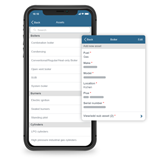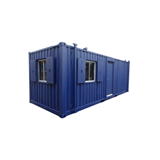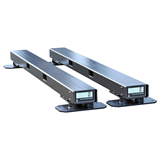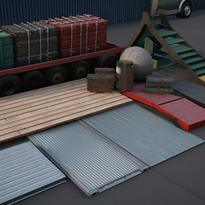Container ramps play a critical role in the efficient functioning of loading and unloading operations in various industries. To ensure that your ramp remains in top-notch condition and meets the demands of the industry, it is crucial to implement a robust maintenance routine. By following these industry-recommended maintenance guidelines, you can keep your container ramp in optimal shape and maximize its performance.
How to Clean and Maintain Your container ramp
1. Regular Cleaning and Inspection
The first step in maintaining your container ramp is to establish a routine cleaning and inspection schedule. Regular cleaning helps remove dirt, debris, and other substances that can compromise the ramp's functionality and safety. Inspecting the ramp allows you to identify any signs of wear, damage, or structural issues early on, preventing them from worsening over time. During your inspection, pay close attention to the ramp's surface, support structure, hinges, and locking mechanisms. If you notice any signs of corrosion, cracks, or loose parts, take immediate action to rectify the problem.
2. Surface Maintenance
The surface of your container ramp plays a vital role in ensuring smooth and secure loading and unloading operations. Over time, the ramp's surface may develop wear and tear, affecting its traction and grip. To maintain optimal performance, periodically check the surface for signs of damage, such as cracks, potholes, or unevenness. Repair any surface imperfections promptly by filling cracks, resurfacing worn areas, or applying anti-slip coatings. Maintaining a well-maintained and level surface will prevent accidents and prolong the lifespan of your container ramp.
3. Lubrication
Proper lubrication is crucial for the smooth operation of the ramp's moving parts, such as hinges and locking mechanisms. Regularly lubricate these components to prevent friction, rust, and corrosion. Be sure to use high-quality lubricants suitable for the specific materials and environmental conditions of your ramp. Apply lubrication following the manufacturer's recommendations, paying extra attention to areas prone to moisture or exposure to harsh elements. Lubricating your ramp will keep it functioning optimally, extend its longevity, and reduce the risk of malfunctions.
4. Structural Integrity
Ensuring the structural integrity of your container ramp is of utmost importance for both safety and longevity. Regularly inspect the ramp's support structure, including the frame, beams, and connectors, to detect any signs of damage or weakening. Look out for rust, dents, or bending, as these can compromise the ramp's load-bearing capacity. If you identify any structural issues, consult a professional for assessment and repair. Strengthen weak points and reinforce connections as needed to maintain the ramp's stability and durability.
5. Weather Protection
Container ramps are exposed to various weather conditions, including rain, snow, heat, and humidity. To protect your ramp from the elements, consider implementing weatherproofing measures. Apply protective coatings to prevent rust and corrosion caused by moisture. Install covers or shelters to shield the ramp from direct sunlight and excessive heat. Additionally, ensure proper drainage to avoid the accumulation of water, which can cause slippery surfaces and structural damage. By safeguarding your ramp against adverse weather conditions, you can prolong its lifespan and maintain its functionality.


Find the right Container Ramp
Compare quotes from expert Australian suppliers and make the best choice. It's free, quick and easy!
Troubleshooting and Maintenance of Container Ramps
Container ramps are essential equipment for smooth loading and unloading operations in shipping and logistics. However, like any mechanical system, they can encounter issues over time. To ensure the optimal performance and longevity of your container ramps, it is crucial to conduct troubleshooting and regular maintenance.
Troubleshooting Common Issues
1. Uneven or Unstable Ramp
Problem: The ramp surface may become uneven or unstable, posing risks during loading and unloading.
Solution:
- Inspect the ramp surface for any deformities or damage.
- Level the ground beneath the ramp to ensure a stable foundation.
- Adjust the ramp's support beams and connections to eliminate any instability.
- Consider using anti-slip coatings or materials to improve traction and safety.
2. Damaged or Worn-out Components
Problem: Components such as hinges, pins, and bolts can wear out or become damaged over time, affecting the ramp's functionality.
Solution:
- Regularly inspect all components for signs of wear, rust, or damage.
- Replace damaged or worn-out components promptly.
- Lubricate moving parts to reduce friction and enhance performance.
- Use high-quality replacement parts to ensure durability and compatibility.
3. Malfunctioning or Loose Safety Chains
Problem: Safety chains play a vital role in securing the ramp during loading and unloading. Malfunctioning or loose chains can compromise safety.
Solution:
- Inspect safety chains for proper attachment and functionality.
- Replace any damaged or worn-out chains.
- Adjust the tension of the chains to ensure a secure connection.
- Regularly test the safety chain mechanism to verify its effectiveness.
4. Surface Coating Issues
Problem: The surface coating of the ramp can deteriorate over time, leading to reduced traction and potential hazards.
Solution:
- Regularly inspect the ramp surface for any signs of wear, peeling, or damage.
- Recoat the surface with appropriate anti-slip coatings as needed.
- Clean the ramp surface regularly to remove debris and prevent buildup.
The Importance of Regular Maintenance for Container Ramps
Container ramps play a crucial role in facilitating the safe and efficient movement of goods between different levels, such as the ground and shipping containers. To ensure optimal performance, extend the lifespan of your equipment, and prevent potential hazards, we have compiled this comprehensive guide on the importance of regular maintenance for container ramps.
-
Enhancing Safety and Preventing Accidents
Regular maintenance of container ramps is essential to enhance safety and prevent accidents. By conducting routine inspections and addressing any issues promptly, you can identify potential hazards and mitigate risks before they escalate. Neglecting maintenance may lead to structural failures, unstable ramps, or damaged components, which can result in accidents, injuries, and property damage. Prioritizing regular maintenance demonstrates your commitment to providing a safe working environment for your employees and visitors.
-
Extending Equipment Lifespan
Container ramps are a significant investment for any business involved in shipping and logistics. Regular maintenance plays a vital role in extending the lifespan of your equipment. By addressing minor issues and performing necessary repairs in a timely manner, you can prevent further deterioration and avoid costly replacements. A well-maintained container ramp will not only function optimally but also provide a better return on your investment over the long term.
-
Ensuring Optimal Performance
Proper maintenance is key to ensuring the optimal performance of your container ramps. Over time, ramps can experience wear and tear due to heavy loads, weather exposure, and regular usage. By conducting regular inspections and maintenance, you can identify and rectify issues such as damaged support beams, loose fasteners, or worn-out surface coatings. This proactive approach ensures that your container ramps perform at their best, allowing for smooth and efficient loading and unloading operations.
Recommended Maintenance Practices
To maximize the performance and lifespan of your container ramps, we recommend following these maintenance practices:
1. Visual Inspection
Perform a visual inspection of the container ramp, focusing on the following areas:
- Structural Integrity: Check for any signs of cracks, rust, or damage to the main framework of the ramp. Ensure all support beams and connections are secure and in good condition.
- Surface Condition: Examine the surface of the ramp for any worn-out or damaged coatings. Repair or recoat as necessary to maintain a smooth and slip-resistant surface.
2. Lubrication
Apply lubrication to moving parts such as hinges, pins, and pivots to ensure smooth operation. Lubricants help reduce friction, prevent corrosion, and extend the lifespan of these components.
3. Load Capacity Evaluation
Regularly assess the load capacity of your container ramp to ensure it aligns with your operational needs. Overloading the ramp can lead to structural damage and compromise the safety of your workers.
4. Repair and Replacement
Promptly address any identified issues or damages. Repair or replace damaged components, such as worn-out safety chains, loose bolts, or damaged ramps. Consult with a professional if significant repairs are required.
5. Cleaning and Debris Removal
Regularly clean your container ramp to remove dirt, debris, and any potential obstructions. This helps maintain proper functionality and prevents slipping hazards.
In conclusion, proper maintenance and regular inspections of your container ramp are vital for ensuring safe and efficient loading and unloading operations. By following the recommended maintenance practices outlined in this guide, you can enhance safety, extend the lifespan of your ramp, and prevent accidents and costly repairs. Conduct routine visual inspections, clean and repair the ramp surface as needed, lubricate moving parts, evaluate load capacity, and promptly address any identified issues. By prioritizing maintenance, you demonstrate your commitment to safety, efficiency, and the longevity of your container ramp. Remember, a well-maintained ramp is key to a smooth workflow and a successful shipping and logistics operation.






-160x160-state_article-rel-cat.png)




